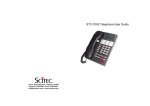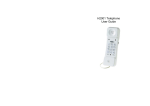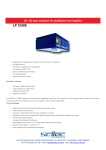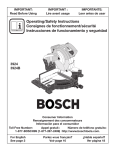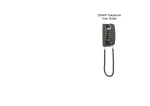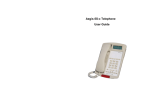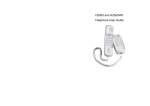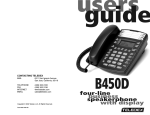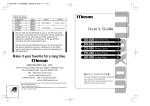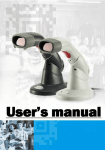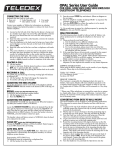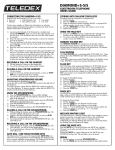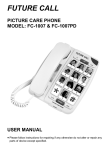Download User Guide
Transcript
STC-7002 Telephone User Guide Unpacking your telephone: The package contains the following items: • Telephone base unit • Handset • Coiled handset cord • Straight line cord Features: 1. Message waiting light and visual ringing indicator: UnaLight message waiting light is compatible with high voltage neon and AT&T/Lucent/Avaya LED message waiting light systems. 2. Speed-dial memory keys: NineTen user-programmable memory keys, each with a capacity of 1632 digits. [FLASH] and [PAUSE] are storable. 3. HOLD key: Each press toggles the “local hold” function alternately on or off. The LED located above this key indicates the on-hold status. 4. STORE key: Used to program speed-dial memory keys. 5. MUTE key: Sets the microphone mute function on and off. The red LED in the SPKR/MUTE indicator displays the on/off status of the mute function. When mute is on, the handset and handsfree microphone audio is turned off. You will be able to hear the party at the other end of your call, but they will not be able to hear you. 6. SPKR key: Sets the handsfree speakerphone function on or off. The green LED in the SPKR/MUTE indicator displays the on/off status of the speakerphone. 7. SPKR/MUTE indicator: A two-color red/green LED located above the [SPKR] key. This indicator displays the status of the speakerphone and hold functions. Red indicates that handset microphone mute is on, green indicates that the speakerphone is on, and red/green indicates that the speakerphone is on with its microphone muted. 8. Ringer volume control switch: Sets the ringer volume level to HI, LOW, or OFF. 9. Volume control key bar: Sets the handset and speakerphone volume to one of four levels [Normal – Medium – High – Highest]. 10. Dataport: Provides a convenient extension of the connected telephone line for connecting a device such as a modem, fax, or answering machine. 11. Hearing aid compatible handset 12. Handset Holder: Clip located above the handset cradle. Used in wall mount applications to conveniently hold an “off-hook” handset. Installation: The STC-7002 telephones are designed for use behind a registered PBX system. The telephone user or system installer must supply an RJ-11 modular wall jack to connect this telephone to the PBX system. The PBX “station port” type must be “Industry Standard Analog” or “POTS.” This telephone cannot be used with “digital” PBX station ports. To install the telephone, first connect the supplied coiled handset cord to the jack on the end of the handset. Place the handset in its cradle. Connect the free end of the coiled handset cord to the jack on the LEFT SIDE of the telephone body, marked with a “handset” symbol. Connect the supplied straight modular cord to the LINE jack located on the rear of the telephone. Connect the remaining end of this cord to the telephone system wall jack. Lift the handset and verify that dial tone is present. Converting to Wall Mount: It is best to perform this conversion prior to connecting the handset and line cords 1. The wall-mount handset hanger is located on the front of the telephone directly above the speaker grill. To change from desk to wall mount, gently slide the hanger out of the telephone body, rotate it ½ turn, then slide it back into the telephone body. In the wall-mount position, the hanger extends upward to hold the handset in place. 2. Turn the telephone over so the telephone face is down. 3. Locate the wall-mounting bracket. Note that there are two types of retaining tabs on the bracket; two of the tabs are hook-shaped. 4. Position the wall-mounting bracket so that the Scitec “Sun” designs are toward the bottom of the phone with the hook-shaped tabs in the slots closest to the top of the phone. 5. Insert the two other retaining tabs into the remaining two slots. Firmly push on the bracket to click it into place. 6. Connect a short line cord into the jack on the rear of the phone. Route the line cord through the line cord channel. Connect the other end of the line cord to the phone jack on the wall. 7. Align both keyholes on the wall-mount adapter with the two posts on the wall-mount jack. Engage the wall-mount bracket with the wallmount plate and slide the telephone downward. When properly installed, the telephone will be firmly attached to the wall. Using the STC-7002 telephone: Placing a call: Using the handset: Lift the handset Using the speakerphone: Press the [SPKR] key. Dial a telephone number by pressing: • The desired digit keys in sequence • The [RD/P] key to redial the last number dialed • A speed-dial memory key to dial a stored number. Other Feature Keys [FLASH] Pressing the [FLASH] key has the same effect as “tapping” the hookswitch. It is used to access PBX system features, such as “system hold,” “transfer/conference,” or “call park.” The standard flash time is 600msec. [FLASH] is storable in the programmable speed-dial memory keys, along with other digits. Please refer to your PBX system manual for additional information and the exact digit sequences required for accessing special PBX system features. [RD/P] Pressing this key immediately after the phone is taken off-hook redials the last number dialed, up to 32 digits. Pressing this key after dialing a digit inserts a 3.6 second pause into the dialing sequence. Setting the Ringer Volume: The ringer volume switch is located on the rear of telephone. It is a slide switch with three positions - OFF, LOW, and HI. Setting the switch to “OFF” disables audible ringing. The “LOW” setting is recommended for most users. The “HI” setting is recommended if the telephone is installed in a noisy location. Answering a call: Using the handset: Lift the handset Using the speakerphone: Press the [SPKR] key. Placing a call on hold: Using the handset: During a call, press the [HOLD] key. Place the handset in its cradle. Using speakerphone: Press the [HOLD] key. Retrieving a held call: Using the handset: Lift the handset. Using the speakerphone: Press the [SPKR] key. Adjusting Handset or Speakerphone Volume Level: Press the [▲] key to increase the volume or the [▼] key to decrease the volume. The volume may be set to one of four levels [Low – Medium – High – Highest]. Speed-Dial Memory Key Programming: 1. Plug the telephone into an active telephone line. This is required to program the speed-dial memory keys. 2. Lift the handset, or press [SPKR] to take telephone “off-hook.” 3. Press the [STORE] key 4. Press the desired sequence of telephone number keys, [FLASH] key or [RD/P] key as desired (up to a total of 1632 keys.) Note: The [RD/P] key will insert a 3.6 second pause into the dialed sequence. If a “9” prefix (or any other digit) is required to access an outside telephone line, a “pause” may be required after the first number dialed. For example: 9 [RD/P] 1 – 800 – 555 – 1212. 5. Press the destination [MEMORY] key (one of nineten available) to store the keyed sequence into memory. 6. (Optional) Press the [MEMORY] key and verify that the programmed sequence is automatically dialed. 7. To program additional speed-dial memory keys, repeat steps two through six. It is not necessary to hang up or hear dial tone prior to programming additional keys. Note - Speed-dial memory key contents are stored in a non-volatile memory. An active telephone line connection is not required to retain the contents of the speed-dial key memory. Flash time is also programmable. The procedure is as follows: offhook+[STORE] key+1 or 3 or 6+[STORE] key+[FLASH] key, here 1,3,6 respectively denotes 100ms,300ms,600ms of flash time. Pause time is also programmable. The procedure is as follows: offhook+[STORE] key+1 or 2 or 3 or 4+[STORE] key+[PAUSE] key, here 1,2,3,4 respectively denotes 1s,2s,3s,4s of pause time. The HOLD mode may be programmed as PBX hold. The procedure is as follows: off-hook+[STORE] key+ PBX hold activating passcode + [STORE] key+[HOLD] key. The procedure to cancel the code setting in Speed-dial keys, [MSG] key, [FLASH] key, [PAUSE] key and [HOLD] key is as follows: offhook+[STORE] key+[STORE] key+ Speed-dial keys, [MSG] key, [FLASH] key, [PAUSE] key or [HOLD] key. Speed-dial Memory Key Labeling (optional): 1. Obtain a pin, sewing needle, knife blade, or similar pointed tool. 2. Press down on the center speed-dial key. Carefully insert the tool in between the upper or lower edge of the pressed speed-dial key and its hole in the faceplate. Pry up on the center of the faceplate and lift upward to remove the faceplate from the telephone. Carefully insert the tool in the right hole in the PVC faceplate. Pry up on the right side hole of the faceplate and lift upward to remove the PVC faceplate from the telephone. 3. Remove the transparent key caps from the nine speed-dial keys. Insert labels of your choice between the keys and the transparent key covers. Directly write your desired telephone numbers in the blanks with underscore. 4. Orient the faceplate so that the two pins molded on the back of the faceplate align with the corresponding holes on the telephone body. Carefully reinstall the faceplate by inserting the four tabs on the faceplate into the four retaining slots on the telephone body.Orient the PVC faceplate by inserting the four tabs on the faceplate into the four retaining slots on the telephone body. Data port: The DATA jack, located on the right side of the telephone, provides a convenient extension of the connected telephone line. This jack may be used to connect a computer modem, credit card terminal, or other similar accessory device directly to the telephone line. Note that the telephone and a connected accessory device are sharing the connected telephone line and may not be used simultaneously. Do not attempt to use the data port for connecting the handset to the telephone. The data port is to be used only for connecting computer modems or similar accessory devices directly to the telephone line. Required FCC Notice: This equipment complies with Part 68 of the FCC rules and the requirements adopted by the ACTA. On the bottom of this equipment is a label that contains, among other information, a product identifier in the format US:AAAEQ##TXXXX. If requested, this number must be provided to the telephone company. The REN is used to determine the number of devices that may be connected to a telephone line. Excessive RENs on a telephone line may result in the devices not ringing in response to an incoming call. In most but not all areas, the sum of RENs should not exceed five (5.0). To be certain of the number of devices that may be connected to a line, as determined by the total RENs, contact the local telephone company. The REN for this telephone is part of the product identifier that has the format US:AAAEQ##TXXXX. The digits represented by ## are the REN without a decimal point (e.g., 03 is a REN of 0.3). If this equipment causes harm to the telephone network, the telephone company will notify you in advance that temporary discontinuance of service may be required. If advance notice isn't practical, the Telephone Company will notify you as soon as possible. Also, you will be advised of your right to file a complaint with the FCC if you believe it is necessary. The Telephone Company may make changes in its facilities, equipment, operations, or procedures that could affect the operation of this telephone. If this happens, the Telephone Company will provide advance notice in order for you to make the necessary modifications in order to maintain uninterrupted service. If you experience trouble with this telephone, please contact Scitec, Inc. at (217) 384-6041 for repair or warranty information. If the trouble is causing harm to the telephone network, the Telephone Company may request that you remove this equipment from the network until the problem is resolved. The customer can do the following repairs: replacement of cords or handset; replacement of window for telephone number. Connection to party line service is subject to state tariffs. Contact the state public utility commission, public service commission or corporation commission for information. This telephone cannot be used on Telephone Company provided coin service. If your home has specially wired alarm equipment connected to the telephone line, ensure the installation of the STC-7002 telephone does not disable your alarm equipment. If you have questions about what will disable alarm equipment, consult your telephone company or a qualified installer. This equipment is hearing aid compatible. If the STC-7002 telephone is used with a leased system, permission of the owner of the equipment must be obtained for connection of the telephone because modification of the host system is often required. Jacks: A plug and jack used to connect this equipment to the premises wiring and telephone network must comply with the applicable FCC Part 68 rules and requirements adopted by the ACTA. A compliant telephone cord and modular plug is provided with this product. It is designed to be connected to a compatible modular jack that is also compliant. See installation instructions for details. The STC-7002 telephones use RJ11C USOC standard modular jacks. Warranty: Scitec, Inc. (“Scitec”) warrants your STC-7002 telephone to be free from defects in material and workmanship for a period of two (2) years from the date of purchase. This warranty applies only to the original purchaser, and only to products employed in normal use and service in standard commercial offices, schools/universities, hotel/motel guest rooms, healthcare facilities, and/or residences. This Warranty is only valid for merchandise purchased directly from Scitec or from an authorized Scitec dealer or distributor. If this product is found to be defective within the terms of this warranty, Scitec's only obligation -- and your exclusive remedy -- is the repair or replacement of this product, at Scitec's discretion, provided that the product has not been damaged through misuse, abuse, accident, modification, alteration, neglect or mishandling. This warranty shall not apply to any product found to have been improperly installed, configured, or used in any way not in accordance with the instructions supplied with this product. For repair or replacement, please call Scitec at (217) 384-6041 to request a “ Return Authorization Form.” A simple one-page form and complete instructions will be sent to you, to be filled out and returned to Scitec. You will be asked to describe the failure symptoms of your telephone, provide the date purchased (and proof of purchase date if requested), and provide the name of the Scitec dealer or distributor from which the telephone was purchased. The completed form may then be faxed or mailed back to Scitec. Then, when your return authorization request has been approved, Scitec will contact you with a “Return Authorization Number” which must be clearly placed on the outside of the box that you use to return your telephone. You, the customer, are responsible for paying all shipping costs to return your defective product to Scitec. Scitec then pays for shipping the repaired or replaced product back to you. Please note that Scitec will not accept, repair, or replace any products returned without a “Return Authorization Number.” Any such product sent to Scitec without a “Return Authorization Number” will either be returned at the customer’s expense or be disposed of. Scitec does not warrant and specifically disclaims any warranty, whether express or implied, of the fitness for a particular purpose other than the warranty contained herein. No implied warranty on this product, created by state law, shall extend beyond the term of this warranty unless such law otherwise provides. Scitec specifically disclaims any liability and shall not be liable for any consequential or incidental loss or damage, including but not limited to damages to any equipment with which this product is used. Some states do not allow the exclusion or limitation of incidental or consequential damages so the above limitations or exclusions may not apply to you. No agent, representative, dealer or employee of Scitec has the authority to increase or alter the obligations or terms of this Warranty. This Warranty gives you specific legal rights and you may have other rights, which vary from state to state.





